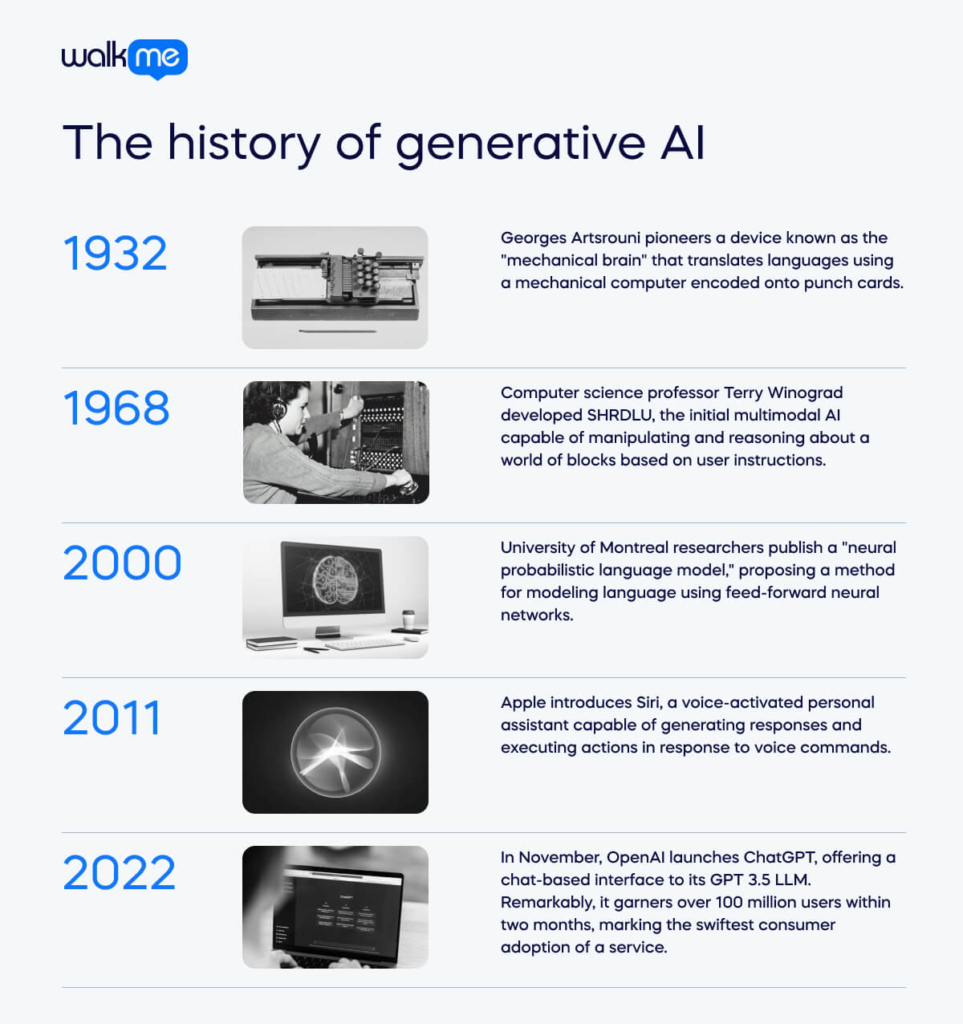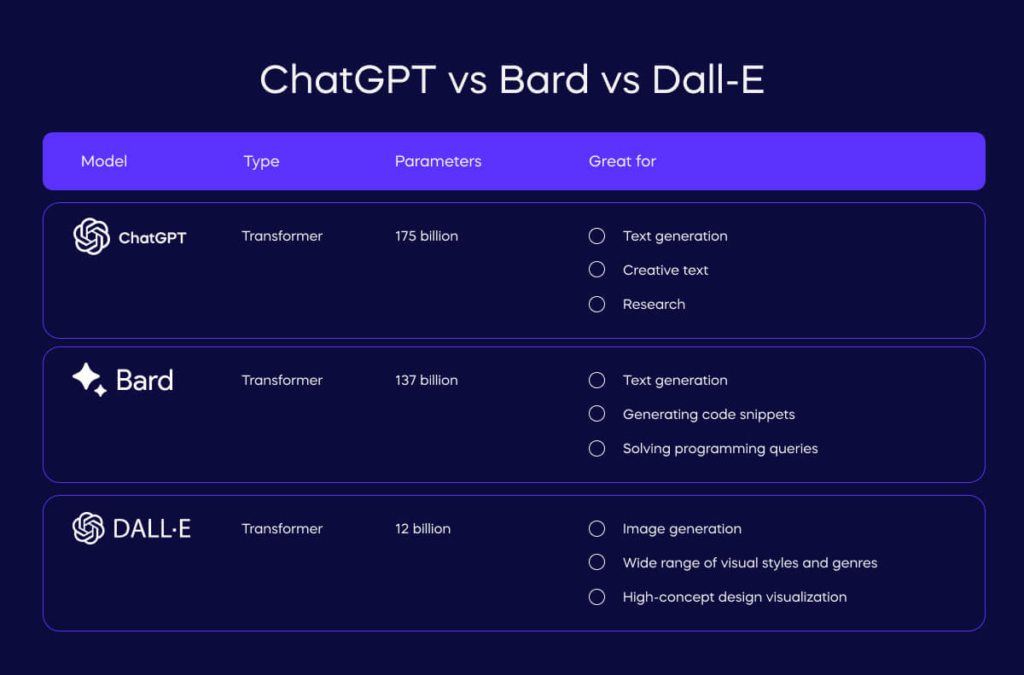Generative AI, a subset of artificial intelligence, is the driving force behind many cutting-edge tools that shape how we work today.
However, despite tools like ChatGPT gaining one million users in the first week of release and one hundred million in the first two months, not everyone knows exactly what generative AI is or how it works.
Generative AI uses large data sets to generate several forms of content, from text to audio to video and images. Enterprises will likely use chatbots to automate customer support and allow human staff to focus on higher-level tasks.
To help you understand what generative AI is, its models, and its use cases, we will explore the following topics:
- What is generative AI?
- How does generative AI work?
- What generative AI model types exist (definition and examples)?
- ChatGPT vs Bard vs Dall-E
- Top industry-specific use cases for generative AI
- Benefits of generative AI
- Challenges of generative AI
- What will the future hold for generative AI?
What is generative AI?
Generative AI is a form of artificial intelligence that can generate diverse content such as text, imagery, audio, video, and synthetic data using machine learning and training data.
This tech is novel, with generative AI beginning in the ’60s with chatbots.
In 2014, the arrival of generative adversarial networks (GANs), a subset of NLP machine learning, empowered generative AI to craft truly authentic images, videos, and audio with real people.
What is the history of generative AI?

Looking at a very brief history of generative AI helps us understand how we developed generative AI tools today.
- 1932: Georges Artsrouni pioneers a device known as the “mechanical brain” that translates languages using a mechanical computer encoded onto punch cards.
- 1968: Computer science professor Terry Winograd developed SHRDLU, the initial multimodal AI capable of manipulating and reasoning about a world of blocks based on user instructions.
- 2000: University of Montreal researchers publish a “neural probabilistic language model,” proposing a method for modeling language using feed-forward neural networks.
- 2011: Apple introduces Siri, a voice-activated personal assistant capable of generating responses and executing actions in response to voice commands.
- 2022: In November, OpenAI launches ChatGPT, offering a chat-based interface to its GPT 3.5 LLM. Remarkably, it garners over 100 million users within two months, marking the swiftest consumer adoption of a service.
Knowing the history of generative AI can help you understand its features today and how to optimize it in your organization.
How does generative AI work?
Generative AI works by learning via large language models, giving it access to large data sets to generate content by accessing recurrent neural networks via NLP machine learning.
At the point of user access, the tool uses the large language model to respond to the user’s prompt, whether text, image, video, design, or musical notes, processed by the AI system.
Generative AI tools are usually very easy to use, making AI digital adoption straightforward and making them an easy choice when considering whether to use AI vs. generative AI.
Diverse algorithms generate new content, spanning essays, problem solutions, or convincing creations from images or audio.
Early generative AI versions necessitated data submission via API or complex processes. Developers grappled with specialized tools and coded applications in languages like Python.
Today, generative AI pioneers prioritize enhanced user experiences, allowing requests in plain language.
Users can fine-tune results after the initial response, providing feedback on style, tone, and other desired elements in the generated content.
What generative AI model types exist?
What are Generative AI models?
Learning all the types of generative AI can be intimidating. Still, understanding the types is useful, as generative AI promises to have a huge impact on businesses in the future.
Four main generative AI models exist, which you must consider if you wish to utilize generative AI in your organization to ensure you choose the right model for your needs.
Transformer-based models
Transformer-based models excel in Natural Language Processing (NLP), comprehending language structure and context.
Trained on extensive datasets, these generative models grasp connections in sequential data like words and sentences.
Examples
Notable examples of transformer-based models include:
- ChatGPT-3.
- Google Bard.
Generative Adversarial Networks
Generative Adversarial Networks (GANs) feature two neural networks, a generator and a discriminator. By competing, they produce authentic-looking data. Both components enhance, yielding more genuine results.
Examples
Examples of generative AI systems using adversarial networks include:
- DALL-E.
- Midjourney.
Variational Autoencoders
Variational Autoencoders (VAEs) utilize encoder and decoder networks. The encoder compresses input data while the decoder reconstructs it into similar but not identical output.
Examples
No tools use VAEs exclusively, but several generative AI tools use this technique as a deep learning method.
Multimodal Models
Unlike other generative AI models, Multimodal Models process various data types simultaneously, like text, images, and audio. They create complex outputs, like generating an image from text prompts and descriptions.
Examples
Examples of multimodal models are:
- DALL-E 2.
- OpenAI’s GPT-4.
Understanding the many generative AI models can help you optimize their use and give developers instructions if you ever need to design a generative AI tool for your organization.
Other AI models deal with planning, robotics, and molecules, but these are rarely used in business. Many AI models are foundation models, of which GPT is one example.
ChatGPT vs Bard vs Dall-E

All generative AI tools are the same; they were just released by different vendors, right?
Wrong. Each works differently, and users must consider which to use for different purposes.
ChatGPT
Type: Transformer
Parameters: 175 billion
Great for:
- Text generation.
- Creative text.
- Research.
Bard
Type: Transformer
Parameters: 137 billion
Great for:
- Text generation.
- Generating code snippets.
- Solving programming queries.
Dall-E
Type: Transformer
Parameters: 12 billion
Great for:
- Image generation.
- Wide range of visual styles and genres.
- High-concept design visualization.
See the sections below to compare ChatGPT, Google Bard, and Dall-E in more detail.
ChatGPT
ChatGPT, a sensation since November 2022, harnesses OpenAI’s GPT AI model. Unlike earlier versions, which were accessible only through an API, OpenAI introduced interactive feedback via a chat interface.
GPT-4 launched on March 14, 2023. ChatGPT retains conversation history, mirroring authentic interactions. Its success prompted Microsoft to invest significantly in OpenAI and integrate GPT into Bing search.
Gemini
Gemini is an AI chatbot that exhibits near-human comprehension in responding to user queries or prompts on diverse subjects. Its capabilities extend to text-based functions, including content creation, summarization, and translation.
Google announced the impending release of Google Gemini in February 2023. Users had to join a waitlist for testing, and by March, it became accessible to the public.
DALL-E
DALL-E, derived from a vast dataset of images and text descriptions, epitomizes multimodal AI. It associates words with visual elements by bridging vision, text, and audio.
Utilizing OpenAI’s GPT framework in 2021, DALL-E 2, a more advanced iteration, emerged in 2022. It empowers users to prompt imagery in diverse styles.
Consider these differences when selecting the best generative AI tool for your needs.
What are the benefits of generative AI?
Generative AI has numerous benefits, starting with a notable decrease in human risk and error.
Lower human risk and error
The foremost advantage of generative AI implementation is minimizing human error and mitigating risks to individuals.
Errors are inherent to human nature, and though not invariably harmful, they can jeopardize result consistency.
Utilizing generative AI, particularly for repetitive tasks, safeguards a product or service from human error, guaranteeing a consistently reliable outcome.
24/7 accessibility
Generative AI programs, unlike humans, function ceaselessly, unbound by an 8-hour workday.
Machines can operate continuously, and generative AI-driven chatbots excel in providing customer service, particularly outside business hours.
This ability empowers companies to boost productivity and offer an exceptional customer experience, surpassing the limits of human efforts alone.
More efficient data acquisition and analysis
In data processing, the sheer volume of generated data exceeds the human capacity for comprehension and analysis.
AI algorithms rescue by adeptly managing extensive and intricate data, rendering it analytically usable.
What are the challenges of generative AI?
Consider the various drawbacks of generative AI to prepare yourself for the forthcoming impact on your organization.
High costs of implementation
The primary and evident drawback of incorporating generative AI resides in its potentially high development costs.
For enterprises seeking innovative solutions, comprehending the usual cost range of AI is essential. Generally, it ranges from $10,000 to $30,000 per software. The baseline cost for a tailored AI solution begins at around $5,000 to $6,000.
While costs tend to stabilize as the generative AI system reaches full functionality and improves workflow efficiency, the initial investment can be formidable, if not prohibitive.
Low creativity and poor emotional input
An additional drawback of generative AI lies in its inability to capture human-like emotions and creativity when making decisions.
The lack of creativity implies that generative AI faces challenges in generating innovative solutions or excelling in highly artistic domains.
This aspect signifies that until generative AI can produce truly original and unexpected ideas, it will lag behind humans in creative capabilities, constraining its effectiveness in decision-making.
When a company seeks a new or inventive solution to a problem, humans are better equipped to offer such solutions.
Ethical factors
The rapid progress and incorporation of generative AI have prompted numerous ethical concerns regarding its use and continuous expansion.
- Job displacement.
- Inquiries about research bias.
- Worries about consumer data privacy.
- Consent for data usage in language learning tools.
Reflect on these ethical considerations to ensure the responsible utilization of generative AI tools.
Top industry-specific use cases for generative AI
Some of the top commercial use cases for generative AI are education and training, finance, legal companies, and supply chain.
See the list below to consider how to benefit from generative AI today.
Education and training
There are many use cases for generative AI within education and training.
Personalized lessons, course planning, and design
Generative AI tools can recommend tailored lessons for students based on their academic history and performance, ensuring effective and personalized education.
Content, image, and video creation for lessons
Generative AI tools like ChatGPT, DALL-E, and other AI-driven animation tools empower educators to craft engaging lessons enriched with simplified content, images, and videos.
Tutoring
Learners of any ability level can engage with a chatbot or virtual tutor for assistance. ChatGPT, an exemplary generative AI tool, adeptly explains intricate concepts to individuals of all ages.
Finance
Finance and banking offer many opportunities for generative AI applications.
Preventing fraud through Generative AI
In today’s landscape, scams abound, and cybercriminals continually devise novel methods to execute deceitful transactions.
Generative AI offers a solution by introducing a tool to identify fraudulent transactions and malicious activities across various accounts.
Enhancing risk management with Generative AI
Banks can harness the power of generative AI’s GAN models to simulate scenarios, such as financial losses, using near-real-life data.
It entails predicting market trends to prepare for potential downturns and devising strategies to navigate market volatility.
Legal
The legal field lends itself well to generative AI practices.
Contract generation and adherence
Generative AI tools, like ChatGPT, can produce a legal contract that is aligned with the agreed-upon criteria and terms among the involved parties.
This efficient process saves time, effort, and money and simplifies proceedings, enabling the prompt initiation of contract execution without complications.
Supply chain
Supply chain services can benefit in many ways from generative AI.
Oversight and demand projection
Leveraging generative AI models enables companies to anticipate product demand, facilitating strategic planning of supply chain operations in alignment with factors like customer volume, product specifications, and additional parameters.
What will the future hold for generative AI?
The remarkable depth and user-friendliness of ChatGPT spurred the widespread adoption of generative AI. But how will it evolve in the future?
Human-level performance
By the end of this decade, generative AI is projected to operate at a median level comparable to human performance across most of the technical capabilities depicted in this chart.
Its competency in executing these tasks is anticipated to rival that of the top 25 percent of individuals, surpassing expert predictions by up to 40 years in certain instances.
Diverse generative AI apps
Current generative AI tools can generate a wide array of content, including written, image, video, audio, and coded materials.
Enterprises are actively crafting applications to address diverse use cases within these domains. In the future, applications tailored for specific industries and functions will deliver greater value than more generalized counterparts.
Priority use cases
Marketing and sales leaders expected a minimum of a moderate impact from every suggested use case of generative AI.
Their greatest enthusiasm was directed towards these three use cases for generative AI in the future:
- Lead identification.
- Marketing optimization.
- Personalized outreach.
Consider how generative AI will impact the future of business today to prepare your organization and stay resilient, competitive, and successful.
Future-proof your organization by optimizing your generative AI knowledge
To future-proof your organization and maintain digital resilience, prioritize optimizing generative AI knowledge.
Stay abreast of transformative technologies, such as transformer-based models, GANs, VAEs, and multimodal models, and how they change over time.
Embrace user-friendly interfaces for seamless integration, fostering efficiency, and keep yourself informed of updates to give your staff the skillsets to navigate evolving landscapes.
This strategic investment ensures adaptability, harnessing the full potential of generative AI for sustained innovation and competitiveness in the dynamic, tech-driven future.


